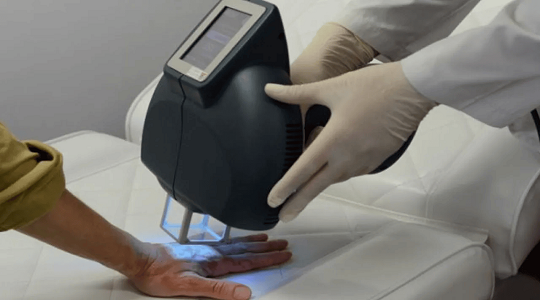Vitiligo Treatment (Laser)
Vitiligo treatment with laser therapy involves using targeted light to stimulate the production of melanin in areas affected by depigmentation. The laser encourages repigmentation, helping to restore skin color and reduce white patches. It’s a safe, effective solution for managing vitiligo, offering noticeable results with minimal downtime. Book your consultation at Derma Solutions today!


Vitiligo is an autoimmune disorder that destroys melanocytes, leading to depigmented skin patches. It typically develops between ages 10 and 30 and is not contagious or physically harmful but can be emotionally distressing, especially on visible areas like the face and hands. Though its exact cause is unclear, genetic and environmental factors likely contribute. Vitiligo often begins as small spots that may spread over time, becoming more noticeable in darker skin tones due to the contrast with unaffected skin.
Laser Treatment for Vitiligo
Laser treatment for vitiligo involves the use of targeted light therapy to stimulate the production of melanin in depigmented areas of the skin. The goal is to restore the color of the affected areas, leading to a more even skin tone and reduced visibility of the white patches. This treatment is non-invasive and relatively painless, making it a popular option for people seeking a safe and effective solution for their vitiligo.
Two common types of lasers used in vitiligo treatment include:

UV Light Therapy (Narrowband UVB)
UV light therapy is one of the most widely used treatments for vitiligo. It involves exposing the skin to ultraviolet light, which helps stimulate the production of melanin in the depigmented areas. Narrowband UVB therapy, which uses a specific wavelength of UV light, has been shown to be particularly effective in promoting repigmentation in vitiligo patients. This treatment is usually performed in a clinical setting, with the patient standing in a specialized UV light chamber. The procedure is non-invasive and requires minimal downtime. Patients typically undergo several sessions over a period of weeks or months for optimal results.

Excimer Laser
The excimer laser is another advanced laser treatment used for vitiligo. This type of laser delivers concentrated beams of ultraviolet light to the affected skin, targeting specific areas with precision. The excimer laser stimulates the production of melanin in the depigmented patches, leading to gradual repigmentation of the skin. Excimer laser treatment is especially effective for localized vitiligo, where the white patches are small and concentrated in specific areas. It can be used on various parts of the body, including the face, hands, and other sensitive areas. This treatment typically requires fewer sessions compared to UVB therapy, and patients may notice significant improvement in as little as a few weeks.
Who is at Risk for Vitiligo?
While vitiligo can affect anyone, certain individuals are at a higher risk for developing the condition:

Family History – A genetic link suggests a higher risk if a close relative has vitiligo or other autoimmune diseases.

Autoimmune Disorders – Conditions like lupus, rheumatoid arthritis, or thyroid issues increase susceptibility.

Genetic Factors – Specific genes may make melanocytes more vulnerable to immune attacks.

Environmental Triggers – Stress, trauma, or chemical exposure can trigger vitiligo in those predisposed.

Age Factor – Most cases develop between ages 10 and 30, though it can appear at any age.
Benefits of Laser Treatment for Vitiligo
Symptoms vary depending on where the infection occurs. With a skin infection, you may experience the following:
- Targeted Treatment – Precisely treats depigmented areas without affecting healthy skin.
- Non-invasive – No incisions or downtime, allowing immediate return to daily activities.
- Minimal Side Effects – Mild redness or irritation, which subsides quickly.
- Quick Sessions – Treatments last only 15-30 minutes, ideal for busy schedules.
- Long-Lasting Results – Gradual repigmentation leads to a more even skin tone.

Causes of Vitiligo
Vitiligo is believed to result from a combination of genetic and environmental factors:
- Autoimmune Response – The immune system mistakenly attacks melanocytes, leading to pigment loss.
- Genetic Factors – A family history of vitiligo or autoimmune disorders increases the risk.
- Environmental Triggers – Sunburn, stress, trauma, or chemical exposure can trigger the condition.
- Neurogenic Factors – Nerve-related chemicals may contribute to melanocyte destruction.
Book your experience
Our expert team is ready to help you achieve radiant, healthy skin with treatments tailored just for you.
Enhance your beauty
Reveal your natural glow with expert beauty treatments designed to enhance your confidence.

Book an appointment

Get your schedule

Meet with our expert





